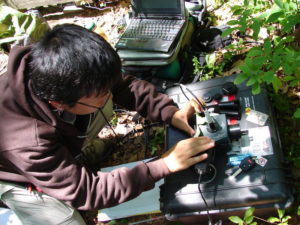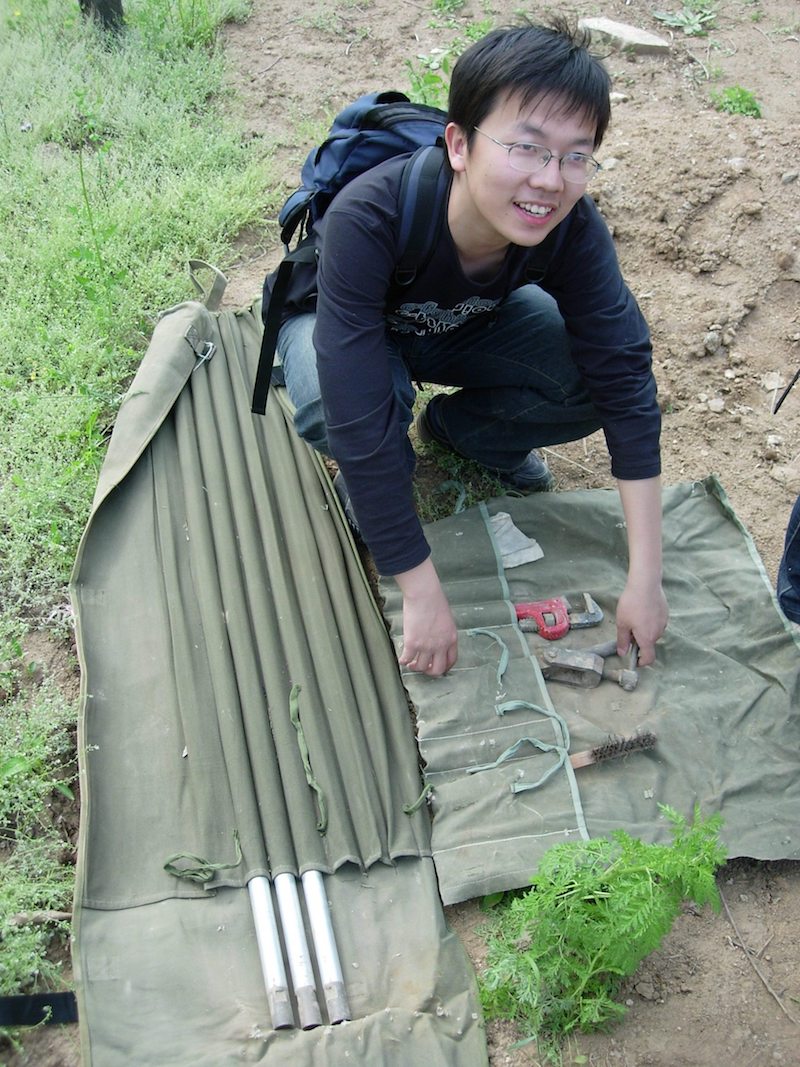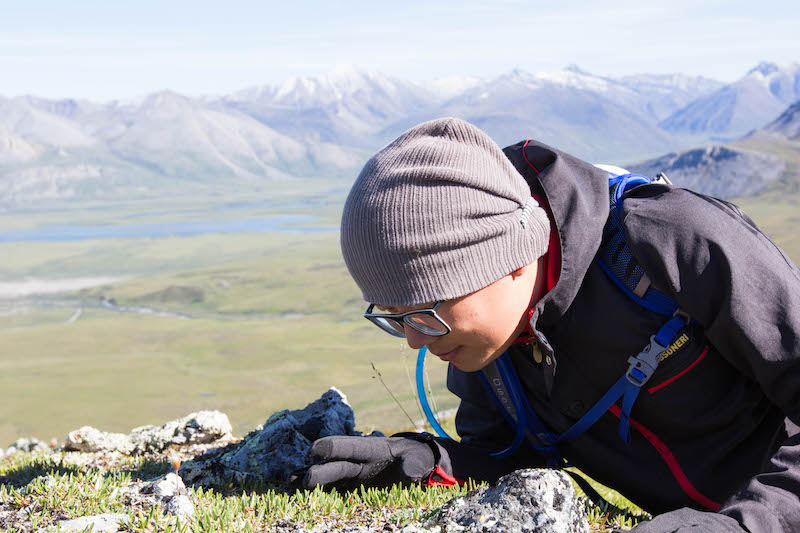
Global Change Ecologist Xi Yang uses drones to gather information about forests.
Which trees have meant the most to you? Why: how did you interact with them?

According to Guinness World Records, the tallest living tree — a Sequoia sempervirens in California’s Redwood National Park — stood 115.85 meters (380 feet and one inch) tall in 2017. Scientists estimate that this tree has stood there for 600-800 years.
In the second decade of this century, from approximately 2011 to 2017, record-breaking hot temperatures in California combined with low rates of precipitation (rain and snow) to cause a drought. Scientists studying that drought determined that it was the worst one in over 1,000 years. They measured tree growth (trees grow faster in wetter years, producing larger rings) and used the North American Drought Atlas to compare California’s recent drought years to other droughts in the state.
Does the height of the world’s tallest tree help it survive? How do changes in California’s climate affect trees? Global Change Ecologist Xi Yang uses drones, spectroscopy, and satellite and airplane images to help us understand how plants like redwoods survive in different environments.
Yang and his colleagues send drones that quickly take many two-dimensional photos into the forest in Virginia. “If you take one image, the next image you take will have a big overlap with the first image.” This tool, called Structure from Motion (SfM), can create a three-dimensional image.
In the past, to figure out when leaves come out or change color in the fall, people had to examine trees themselves, working manually (without the tools available today). Yang estimates that they could only “monitor 20 to 30 or maybe 50 trees, like Henry David Thoreau did when he wrote Walden Pond.” And that made it “difficult to do long-term observation.”
But “drones can allow you to monitor 2,000 trees within an hour” and make sure that your work is consistent and objective. With their fleet of five drones and other tools, Yang and his students explore questions like What makes certain trees put out their leaves earlier than other trees? How can we measure the rate of photosynthesis in different trees? How do the temperature of a forest’s canopy and the amount of ozone and other pollutants in its air affect plants living there?
Advanced tools also help them investigate what factors affect the survival of trees in times of drought. “We counted the life and death of over 1.8 million trees. Kids can take a satellite image [of] a small area with maybe 50 trees and see which are dead or alive. We developed an automated algorithm to identify dead trees.”
Examining evergreen trees standing in a 40,000-hectare area of California during the 2012-2015 drought, Yang and his colleagues used a technique called Light Detection and Ranging (LiDAR) to figure out how tall the trees were. LiDAR uses a laser to send out photons (tiny particles of light). The photons bounce off of any objects they encounter. The speed with which they return provides information about those objects, including their distance from the laser. LiDAR also uses a scanner and GPS (a global positioning system). Together, these tools create three-dimensional images, helping driverless cars navigate their environment safely and scientists measure elevation and create detailed maps.
Yang and his team also did a color analysis to determine whether the trees were alive or dead. As you might expect, living evergreens are … green. Dead ones are brown.

After gathering data on the heights and colors of the trees, the team analyzed that information, using regression analysis to compare other variables for the living and dead trees. Did the height of the trees or the temperature, the texture of the soil, the percent of tree cover, the slope of the land, the amount of rainfall in a given area, or the vapor pressure deficit (VPD, which measures the air’s dryness) where a tree stood determine its chances of staying alive?
“If you normalize all of these variables,” you find out how important each one is for trees’ probability of surviving in the drought. And height turned out to be the most important one. “In a nutshell, we found that taller trees are more likely to die in an extreme drought like the one in California.”
Some people study Guinness world records, memorizing all sorts of extreme facts. Others, like Xi Yang and his son Ryan, study maps, memorizing the names and locations of each of the states in the U.S., countries around the world, and their capitals. Yang, who grew up in the Sichuan province of southwest China, and his son, an eight-year-old growing up in Virginia, love to read and study maps.
Xi (pronounced “Shee”) spent a lot of time outdoors as a child. “In the southern part of China, we don’t usually have heating in the winter” and it was “pretty cold indoors. I was born in a small town, surrounded by a lot of hills. We got to play in nature” in and around that town, which is not far from the bamboo forest where the movie “Crouching Tiger, Hidden Dragon” was filmed.
Xi’s parents “supported my curiosity,” encouraging him to read books beyond those required for his classes and entrance examinations. They helped him find and spend time reading “seemingly irrelevant books,” covering subjects “from social science to math.” Xi’s father taught high school and both of his parents had friends with many books. He remembers going to the home of one friend of his father’s and borrowing books from him. “At that time, the internet was still not a thing in China and you had to buy [or borrow] everything locally.”

Also, “culturally in China at that time, when kids were asked ‘What do you want to do when you grow up?’ a standard answer was ‘I want to grow up to be a scientist.’” Following through on this ambition, Yang went to Beijing Normal University, where he chose to study geography for his Bachelor of Science. Geography in China combined meteorology with other ecology-related topics, including GIS (Global Information Systems) and remote sensing. “I chose remote sensing as my major,” partly because “there’s a lot of math in it” and partly because “we do a lot of programming and I like the feeling of being able to quantify processes.”
“I did my masters using satellite images for drought monitoring in China.” These helped him determine how hot and how green the surface of a given area was and whether it was “dry or under drought stress.”
Yang continued his studies in the United States, at Brown University, where he did doctoral and post-doctoral work in Earth, Environmental, and Planetary Sciences, and at the Marine Biological Laboratory in Woods Hole, Massachusetts. Later, he joined the faculty in the Department of Environmental Sciences at the University of Virginia, where he worked when he spoke with Math4Science.
Why does being tall make it more likely that a tree living in dry conditions will die? Xylem (pronounced zye-lehm) pulls water from a tree’s roots up to its leaves. Most of the material we call “wood” is xylem. Yang explains that “tall trees are basically like a straw that you would use to suck juice out of a glass. The taller the tree or straw, the more effort it takes to pull the water or juice up.” If the water a tree pulls up from the soil has to travel a long distance, “the pressure on the xylem increases.” This added pressure can break and then kill a tree under drought conditions, when the soil contains less water and temperatures are high.
The information that Yang and his colleagues gather has important implications for people interested in protecting forests. “Tall trees are major players in sequestering carbon.: And, like other plants, they absorb carbon dioxide and release oxygen.
In addition, “those big trees serve as a way to pump water out of the ground and form rainfall. When you lose them, that affects rain formation and reduces precipitation.
The work of global change ecologists like Xi Yang help us learn what these vital organisms require to survive. We can literally thank them for protecting the water we drink and the air we breathe.



